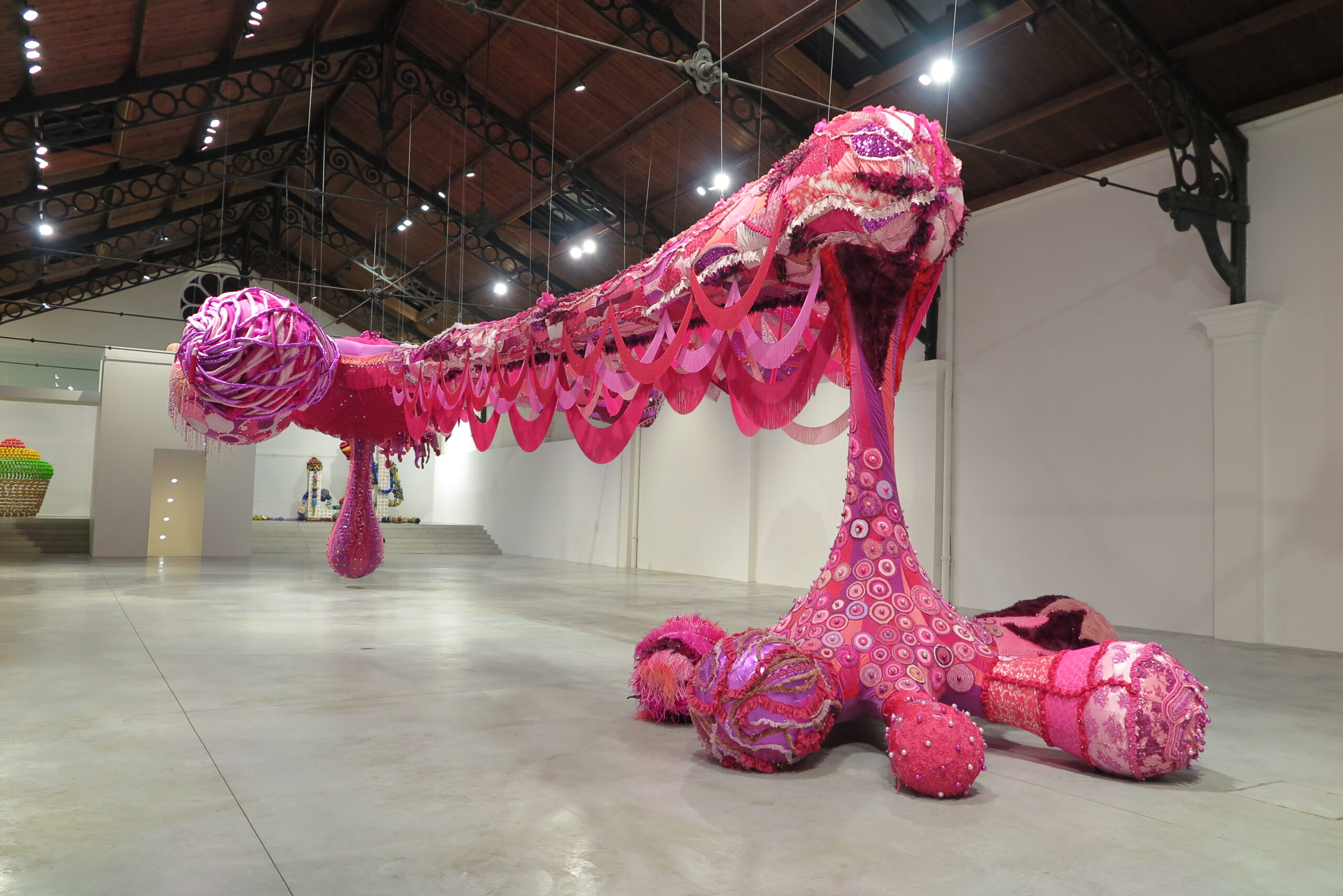
Joana Vasconcelos was born in Paris in 1971 to exiled Portuguese parents. After the Carnation Revolution of 1974, she and her family returned to their native Portugal, where Vasconcelos would develop her style in her Lisbon studio.
In 2005, she exhibited at the first Venice Biennale curated by women, where she garnered international attention with her work A Noiva (The Bride). In 2012, Vasconcelos was the first woman and youngest artist to present her work at the Palace of Versailles. In 2018, she became the first Portuguese artist to hold a solo exhibition at the Guggenheim Bilbao.
Valkyries
Among the artist’s most seminal works are her colossal Valkyries, inspired by the female warriors from Norse mythology. A kaleidoscopic fusion of crocheted wool and cotton, passementerie, piping, stuffing, sequins, beads, feathers, tassels, and LED lights, these suspended fabric sculptures usher the viewer into a dazzling new ecosystem. Rife with rich materials, Vasconcelos’ looming Valkyries pulse with life, taking on shapes that are visually evocative of human organs.
With Valkerie Mumbet, Vasconcelos pays tribute to Elizabeth “Mumbet” Freeman, who contributed to the abolition of slavery in the Commonwealth of Massachusetts after suing for her rights of freedom in 1781 based on the Massachusetts constitution.
Valkyrie Miss Dior is the site-specific sculpture created for Dior’s 2023 Fall/Winter collection. It commemorates three important figures in French history: Catherine Dior, Édith Piaf, and Juliette Greco. Another, named simply Simone, is an homage to French human rights activist Simone de Beauvoir, who laid the foundation for contemporary feminism.
Portuguese Tradition
Despite working across a range of media and using a wide selection of materials, one aspect of Vasconcelos’ oeuvre remains consistent: the interweaving of elements from her Portuguese heritage. Vasconcelos has repeatedly drawn from Portuguese tradition throughout her career, even collaborating with local artisans to realize many of her works.
Among her numerous installations in celebration of Portugal are Pop Galo (2016), a rooster—the nation’s traditional symbol—comprised of 15,000 LED lights and glazed tiles, Flaming Heart (2022), a giant dangling fabric heart inspired by the Portuguese heart of Viana, as well as a series of ceramic animals for which the artist used materials from the historic Portuguese Caldas da Rainha factory.
Vasconcelos at the Uffizi
In 2023, Vasconcelos was invited to present three of her works at the Uffizi Gallery as part of an initiative begun by director Eike Schmidt to bring more recognition to female artists. In her exhibition, Between Sky and Heart, Vasconcelos’ intrepid installations enter a powerful dialogue with the hosting gallery space, blending myth, history, and tradition within the walls of one of the world’s most important museums.
“I am a contemporary artist, taking part in the creation of this historical time, and I would never have dreamt of exhibiting alongside Leonardo Da Vinci, Michelangelo, Botticelli or Caravaggio,” Vasconcelos told DailyArt Magazine. “This invitation from the Uffizi’s director was a huge honor. Because regardless of whether we talk about living or dead artists, what matters the most is the dialogue generated between the artworks.”
Marilyn is a colossal pair of high heel sandals made of stainless-steel pots and lids. With readymade genius, the work highlights the limitations placed on women through the decontextualization of traditionally female utensils. Ordinary household objects become tools for challenging gender paradigms.
Royal Valkyrie, from the artist’s Valkyrie series, is a sprawling installation that presents the traditionally feminine craft of sewing with fresh dynamism. Drawing on a long female tradition, this sculpture recalls the hanging fabric works of such artists as Magdalena Abakanowicz and Louise Bourgeois.
Happy Family is a rare spinoff of the Holy Family, a motif that has been portrayed repeatedly by male artists throughout history. Vasconcelos wraps the three members of the Biblical family with crocheted lacework—another nod to her Portuguese heritage—replacing them with Flora and Bacchus from Roman mythology. The work pushes us to challenge traditional iconography while exploring themes of life, rebirth, and eroticism.
Unraveling Vasconcelos
Thought-provoking and grandiose, Vasconcelos’ large-scale installations feature a blend of Pop art rooted in the Portuguese Baroque. Using various materials and motifs to explore gender, consumer culture, and femininity, her work is deeply intertwined with her country’s tradition. Everyday objects become instruments that prompt the viewer to consider questions related to societal standards and the female condition. These and other themes form the conceptual fabric of Vasconcelos’ oeuvre.
